From exploring the region’s tragic World War II history to hiking through epic national parks, here’s our list of the best things to do in Kanchanaburi, Thailand.
Tourism in Thailand has been growing exponentially for decades thanks to its diverse range of epic landscapes, delicious food, fascinating culture, and friendly people.
Destinations like Bangkok, Phuket, and Chiang Mai are amongst the most popular spots to visit, and it’s not uncommon for tourists to go back to these same places year after year.
Having spent almost 9 months total in Thailand, we’ve been lucky enough to get quite in-depth into the country.
And every time we return, we fall more and more in love with the new places we get to discover.
For those that love exploring regions that are a bit more off the beaten path though, or just anyone that loves a mix of natural wonder and history, Kanchanaburi has been rising on the list of top places to visit in Thailand.

Table of Contents
- Top 11 Things to Do in Kanchanaburi
- Walk Over the Bridge over the River Kwai
- Visit the Kanchanaburi War Cemetery
- Ride the Thai-Burma Railway (Death Railway)
- Explore Tham Krasae
- Learn the History at Hellfire Pass Memorial Museum
- Stay in a Floating Raft House
- Wat Sam Prasop (the Sunken Temple), in Sangkhla Buri
- Mon Bridge for Sunrise
- Visit a Waterfall (Kroeng Krawia Waterfall or Erawan Falls)
- Stay in a Homestay in Baan Nong Khao Village
- Tham Than Lod National Park
- Kanchanaburi Travel Guide
Top 11 Things to Do in Kanchanaburi
Located in the central-western part of the country, only a few hours from Bangkok, Kanchanaburi is a splendid destination to spend anywhere from a few days to a week.
With dense national parks that are still home to wild tigers and elephants, quaint farming villages that beg to be explored on bicycles, right up to some of the most interesting (and tragic) World War II history monuments in the country, there’s no shortage of Kanchanaburi attractions to keep you busy.
There is the gorgeous Erawan National Park, as well as the Death Railway Museum and the Kanchanaburi War Cemetery and other incredible attractions.
Here’s our list of the best things to do in Kanchanaburi on your next trip.
READ MORE: Here’s our ultimate guide to travelling in Thailand.
Walk Over the Bridge over the River Kwai
One of the most iconic places to visit in Kanchanaburi is the Bridge over the River Kwai, and this is where most people start their exploration of the area.
This bridge was built during World War II and is the symbol most associated with the infamous Burma Railway.
Originally built by Allied prisoners of war in 1942 and 1943, the Bridge over the River Kwai wasn’t actually the most important element of the railway during the fighting.
In fact, its claim to fame was being the only steel bridge the Japanese commissioned to build in Thailand (the rest were timber).
It was only when the Hollywood movie, ‘Bridge on the River Kwai‘ came out that it was immortalized, and the influx of tourists that came searching for the bridge actually encouraged the locals to change the name of the river from Mae Klong to Kwae Yai.
Today the bridge stands as a reminder of this history, and every day hundreds of people walk across its length to create their own memories of the Bridge on the River Kwai.
Out of all Kanchanaburi attractions, the Bridge on the River Kwai is the most well-known one.

Visit the Kanchanaburi War Cemetery
During the construction of the Burma Railway, over 100’000 people lost their lives, including 12’000 prisoners-of-war and more than 90’000 civilian labourers.
The death toll during this two-year period is hard to comprehend, especially when you take in that the majority of those who perished were civilians, forced into slavery by the Japanese soldiers.
You might not want to spoil your mood when on holiday by visiting sites that tell such painful stories, but it’s important to honor and remember the fallen. This is one of the most important things to see in Kanchanaburi, if you wish to understand the locals a bit more.
Out of the foreigners who never lived to see the end of the war, more than half of them are buried in the city at Kanchanaburi War Cemetery, also known as Don-Rak.
6982 prisoners-of-war from a mix of nationalities are buried at the Kanchanaburi War Cemetery, primarily being Australians, British and Dutch.
For those looking to pay their respects to the fallen, Kanchanaburi War Cemetery is the main place to do so.
The soldiers’ graves are set in rows, and is maintained by the Commonwealth War Graves Commission.
If you do visit, please show some respect to the deceased. We saw multiple people stepping over graves, waving selfie sticks around and yelling across the cemetery to their friends. This is not cool behaviour.
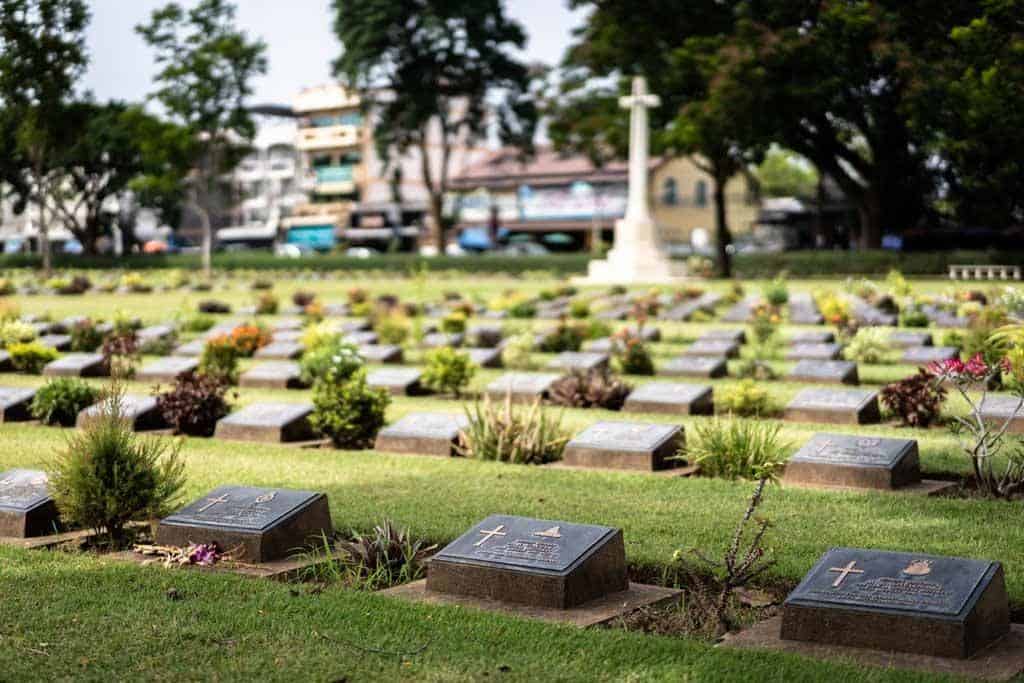
Ride the Thai-Burma Railway (Death Railway)
The Thai-Burma Railway was dubbed the Death Railway by the POWs and labourers who were forced to build it, and you don’t need much of an imagination to realise why.
The 415km-long Death Railway train track joined Ban Pong in Thailand with Thanbyuzayat in Burma (now Myanmar) over incredibly rough terrain.
The British had plans to build this railway for years but abandoned it due to the difficulty and intense labour that would be required to complete it.
When the Japanese invaded Thailand, they set about to achieve what the British could not by building the bridge – and it took them 12 months.
After the war, the Death Railway was closed down in 1947, but a section of it reopened a decade later.
Today you can ride the Death Railway from Kanchanaburi to Nam Tok on a scenic and slow 2-hour journey.
You’ll pass through sprawling farmland, along the edge of steep cliffs, through deep cuttings and along the shores of the Khwae Yai River.
Riding the Death Railway is one of the main things to do in Kanchanaburi, and you can buy your tickets at the train station. It really adds a dose of excitement to Kanchanaburi sightseeing.
You can also visit the Death Railway Museum to learn more. Also called the Thailand Burma Railway Centre, the interactive Death Railway Museum tells the history of the famous landmark.
Check out this awesome 1-day tour where you will learn more about how the “Death Railway” came to be and see in person the iconic bridge over the River Kwai Yai.
NOMADasaurus Tip – Sit on the lefthand side of the Death Railway train for the best views.

Explore Tham Krasae
After an hour or so on the Burma Railway you come to a little station at Lum Sum.
Here you’ll find the cave known as Tham Krasae (Tham means cave in Thai), a large limestone cavern that has been filled with Buddha statues.
The train will stop at Lum Sum, giving passengers a few minutes to check out Tham Krasae and the views along the bridge.
It’s not as impressive as some of the other Buddha caves you find in other places around Thailand, but it’s worth checking out during the stop.
Don’t dawdle though, as the train will leave without you.
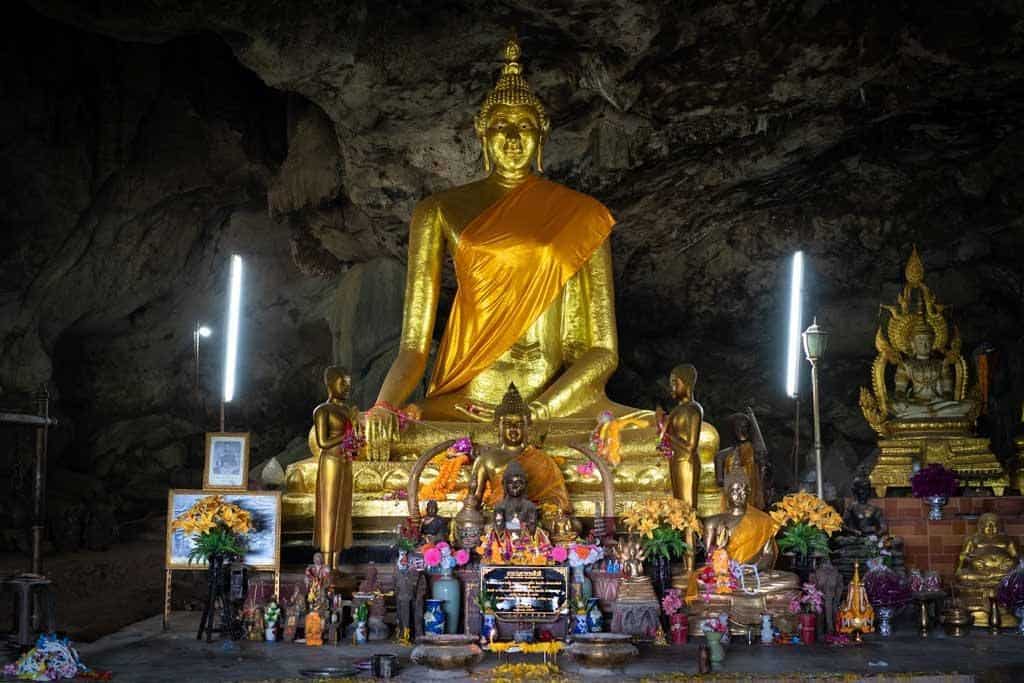
Learn the History at Hellfire Pass Memorial Museum
In the town of Sai Yok, just north of Nam Tok, you’ll find the fantastic Hellfire Pass Memorial Museum and interpretive centre. It’s a Kanchanaburi must see for all history fanatics!
This museum, built by the Australian government, is one of the best we have seen in Thailand, and it is filled with haunting pictures and videos of conditions the POWs were forced to live in during World War II.
Hearing the testimonials of the former soldiers is incredibly sad, but it also gives an insight into just how strong the camaraderie of the ANZACs was.
The museum is located above Hellfire Pass, a deep rock cutting that the Burma Railway passes right through.
This particular point was considered to be one of the deadliest and most difficult sections of the entire construction, and today a memorial walk has been built to allow travellers to wander through its harrowing pathway.
We recommend getting the audio guide from the museum so you can listen to stories of what it was like in Hellfire Pass while you walk through.
If you look carefully you’ll even see remnants of the hand tools used by the POWs buried into the rocks.
No list of what to do in Kanchanaburi is complete without a visit to this centre.

Stay in a Floating Raft House
One of the absolute best Kanchanaburi activities you can enjoy is to spend the night in a bamboo floating raft house.
The name gives it away – this unique accommodation style is quite literally floating on the River Kwai, anchored to the shore but bobbing gently as the water rushes by.
You cannot get any more waterfront than this. You cross a small bridge to get to your individual rooms, which are tastefully decorated and come with private ensuite.
The back sliding door opens to your own private balcony overlooking the jungle and mountains across the other side of the river.
We personally stayed in Boutique Raft House and absolutely loved it. Don’t travel to Kanchanaburi without booking a night here!

Wat Sam Prasop (the Sunken Temple), in Sangkhla Buri
Two hours up the highway from Hellfire Pass is the town of Sangkhla Buri, set on the northern edge of the Khao Laem Reservoir.
Sangkhla Buri is a popular destination for Thais who want to experience a relaxed, authentic way of living that has been lost in the big cities, but it’s still off the radar for most foreign tourists.
The town has a number of attractions, with the most popular one being the famous sunken temple, Wat Sam Prasop.
In the 1980s the Vajiralongkorn hydroelectric dam was built, flooding the region and creating the Khao Laem Reservoir.
A lot of villages were destroyed in the lowlands, and some of the temples were either fully or partially submerged.
Today when the lake is low you can see the tops of some of these temples protruding from the surface, and they are an intriguing place to visit.
Wat Sam Prasop is the most prominent of these sunken temples, and the furthest away from town.
Close to Wat Sam Prasop is a larger temple on high ground that is slowly collapsing, and you can walk around to check this out.
One of the other temples you can visit is up on a hill, and has been slowly taken over by trees. It has a Tomb Raider feel about it.
You can book a sunken temple tour at the Mon Bridge, where a local will take you out on their boat to visit the underwater temples as well as the ones on land.
During our time in Sangklha Buri, we stayed at the Samprasob Resort, which was very close to the Mon Bridge and had great facilities (and views).
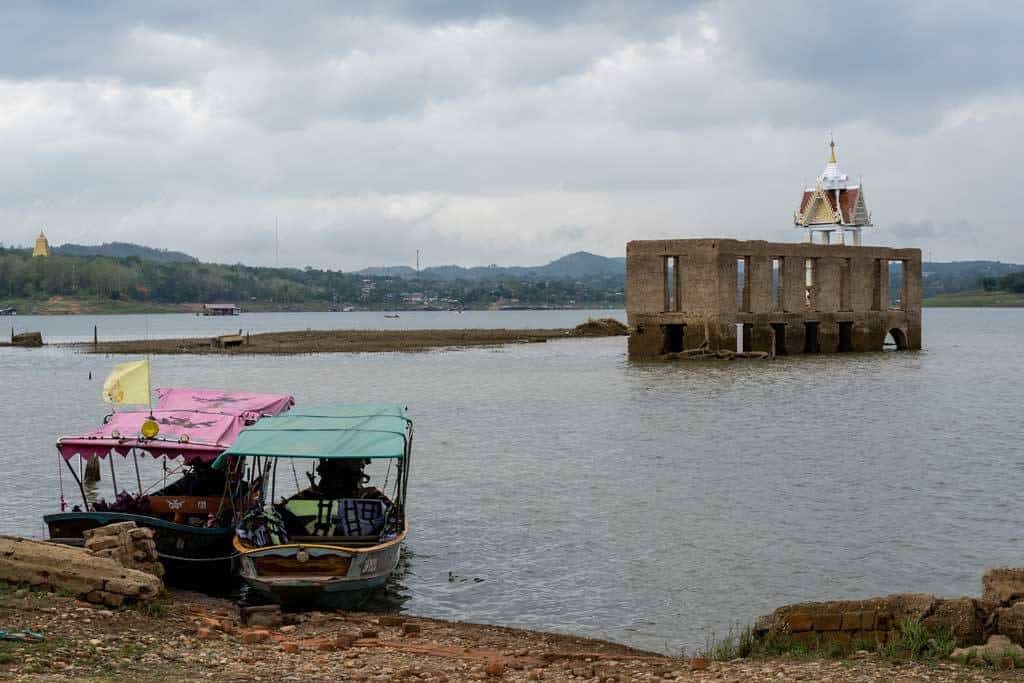
Mon Bridge for Sunrise
The most iconic attraction in Sangkhla Buri is the 400m-long Mon Bridge, the longest handmade timber bridge in the entire country.
Walking across this bridge is a must for any time of day, but it’s especially magical in the morning for sunrise when the monks come down to collect alms from the locals.
The streets are lined with people who wake early to give food and donations to the Buddhist monks.
It’s a very old tradition, and while it’s been turned into a tourist attraction in some places like Luang Prabang, here in Sangkhla Buri it has kept its authenticity.
If you want to take part you can buy alms to give to the monks from vendors on the street.
We found the ceremony on the southern side of the bridge, in the Mon Village, was more interesting and lively.
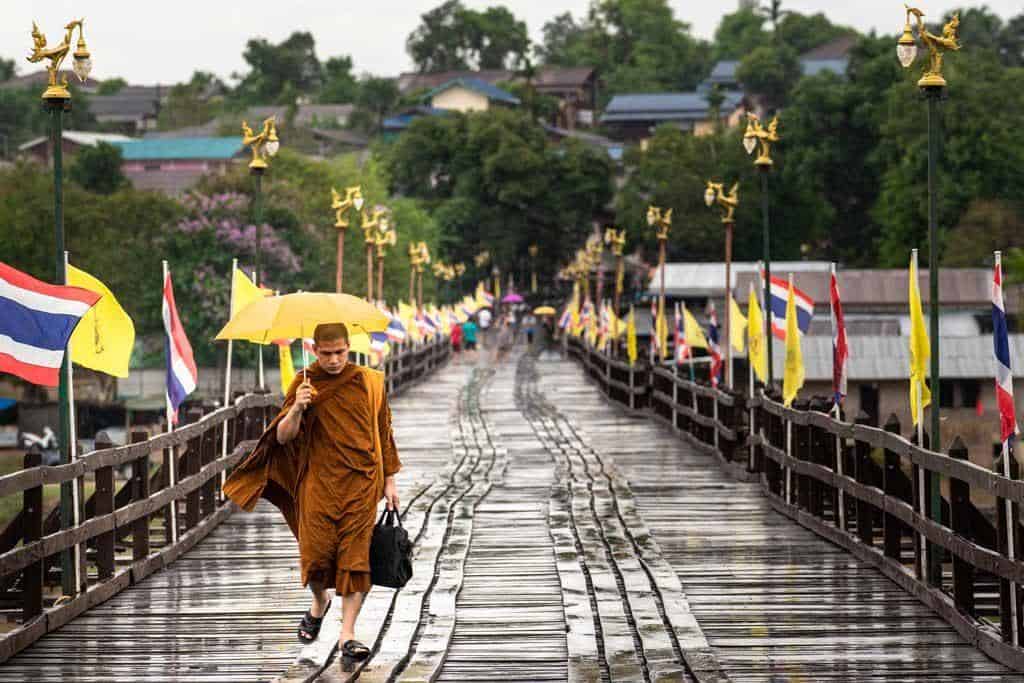
Visit a Waterfall (Kroeng Krawia Waterfall or Erawan Falls)
Off the 323 highway on the way south of Sangkhla Buri is the picturesque Kroeng Krawia waterfalls.
Located on the edge of the Khao Laem National Park, the Kroeng Krawia falls are quite literally on the side of the road, so there’s no excuse to not stop and go for a walk through them.
The river here flows over a number of small limestone rocks, and the surrounding jungle gives it a stunning atmosphere.
It’s not as impressive as Erawan Falls, but it’s a great place to wander around, stretch the legs and take some pictures.
There’s a little cafe near the main entrance that serves great espressos as well.
Another option is taking a day trip to Erawan National Park which is just one hour from Kanchanaburi.
Erawan Falls is one of the area’s most stunning waterfalls, and there are some amazing natural sights and hiking trails in Erawan National Park.
Book this amazing 3-day tour where you will see all the important highlights such as bridge over the River Kwai, Hellfire Pass, Erawan Falls and the floating market!
Or you can just book a one day tour to Erawan National Park and Falls which includes the River Kwai. This one is a bit cheaper as it’s just a day trip!

Stay in a Homestay in Baan Nong Khao Village
Just outside of Kanchanaburi city is the quaint little village of Baan Nong Khao.
This farming village is the kind of place where you’re more likely to encounter cows on the road than people, and that’s totally fine by us.
You can actually stay the night in Baan Nong Khao in one of the nicest little homestays we’ve experienced in years, Baan Klang Thung Organic Farm Homestay.
This gorgeous guesthouse is run by the friendliest family ever, and they absolutely love having visitors stay with them.
Their property is really pretty, with a nice garden and sitting area to relax in during those hot summer days.
We stayed in the upstairs loft, which was quite comfortable with an open-roof bathroom attached.
They also make some delicious food here, and we were even allowed to come into the kitchen to help out making dinner. If you ever need a good Tom Kha Gai, we’re pros now!
While we were staying at the guesthouse we rented some bicycles off of them, and rode into Nong Khao town to check out some of the attractions.
The main thing to see there is Wat Intharam, a large Buddhist complex, but there’s also a traditional loom house and lots of interesting back alleys.
We loved our time staying at the Baan Klang Thung Organic Farm Homestay, and highly recommend it when travelling to Kanchanaburi.
Here’s a decent post with information on how to book the homestay.

Tham Than Lod National Park
The Chaloem Rattanakosin National Park, known to most locals as Tham Than Lod, is a wild, magnificent place a few hours north of Kanchanaburi.
When we say wild, we mean wild. There are still elephants and tigers wandering around in the highlands, and it’s not uncommon for villagers living inside the park to be frequently visited by these captivating animals.
Most tourists though won’t get the chance to see tigers or elephants in the wild, so instead they’ll have to settle for hiking through some of the most beautiful forests we’ve seen in all of Thailand.
The Tham Than Lod National Park has a number of hiking trails that twist their way through the area, as well as a number of caves to explore.
The most popular trail goes through Tham Than Lod Noi, a long limestone cave that has a boardwalk installed right through it.
It’s lit during the day so you can walk to the end without the need for flashlights.
The stalactites and stalagmites aren’t as massive as some other caves we’ve seen in Southeast Asia, but it’s still very impressive.
Once you walk through Tham Than Lod Noi you follow the trail up to a swimming hole, and can then push on to a large waterfall.
Beyond that you come across hundreds of timber steps that take you high into the mountains. It’s a workout on the legs, but definitely worth it for what lies at the top.
The views from the top of the staircase are wonderful, but if you go a little bit further you’ll find Tham Than Lod Yai.
This enormous cave rises above the jungle, allowing passage through as if it was a tunnel, and has an unbelievable opening where the ceiling has collapsed.
Once you get past the cave there’s a small Buddhist monastery at the top, but it’s more functional as opposed to touristy.
All up the hike shouldn’t take more than two hours one-way. We organised a lift to the top with one of the park rangers and walked downhill.
If you want to do something different compared to all the other tourists ticking off things to do in Kanchanaburi, this national park is a great place to visit.

Kanchanaburi Travel Guide
A visit to Kanchanaburi during your trip to Thailand is a marvellous way to spend part of your holiday, and we’re so glad we headed here.
Here are some travel tips to help you plan your vacation when looking for the best things to do in Kanchanaburi, Thailand.
How to Get to Kanchanaburi
Our guide to the best way to get around the region. For internal transport in Thailand, we recommend booking ahead with 12go.asia.
Flying
The closest major airport to Kanchanaburi is in Bangkok, where they have both an international and domestic airport.
It’s a major hub, servicing destinations all around the world. Once you land in Bangkok you can either take a taxi to Kanchanaburi or use one of the other methods of transport below.
Buses
Kanchanaburi is very well connected with the rest of Thailand through their expansive bus network.
From Bangkok, you can take buses from either the Sai Tai Mai (Southern) or Morchit (Northern) terminals. Expect to pay around 120THB for the 4-hour journey.
You can also take long buses from Chiang Mai, or come from across the border in Myanmar at the Pum Nam Ron border crossing.
Trains
By far the most comfortable way to get to Kanchanaburi is to take the train.
Trains leave from Thonburi (Bangkok Noi) train station for Kanchanaburi, and will take 3-4 hours.

Best Time to Visit Kanchanaburi
Kanchanaburi has two main seasons – winter (dry) and summer (wet).
The best time to visit Kanchanaburi is without a doubt from November to February, when temperatures are much milder.
If you choose to travel during the summer, May to September, expect the mercury to hit over 40 degrees and have very high humidity.
The shoulder seasons (March/April and October) are also good times to visit, as you’ll find many accommodations have cheaper prices still, and the weather is much more manageable compared to summer.
DISCLAIMER: Some of the links in this article are affiliate links, which means if you book accommodation, tours or buy a product, we will receive a small commission at no extra cost to you. These commissions help us keep creating more free travel content to help people plan their holidays and adventures. We only recommend the best accommodations, tours and products that ourselves or our fantastic editorial team have personally experienced, and regularly review these. Thanks for your support, kind friend!

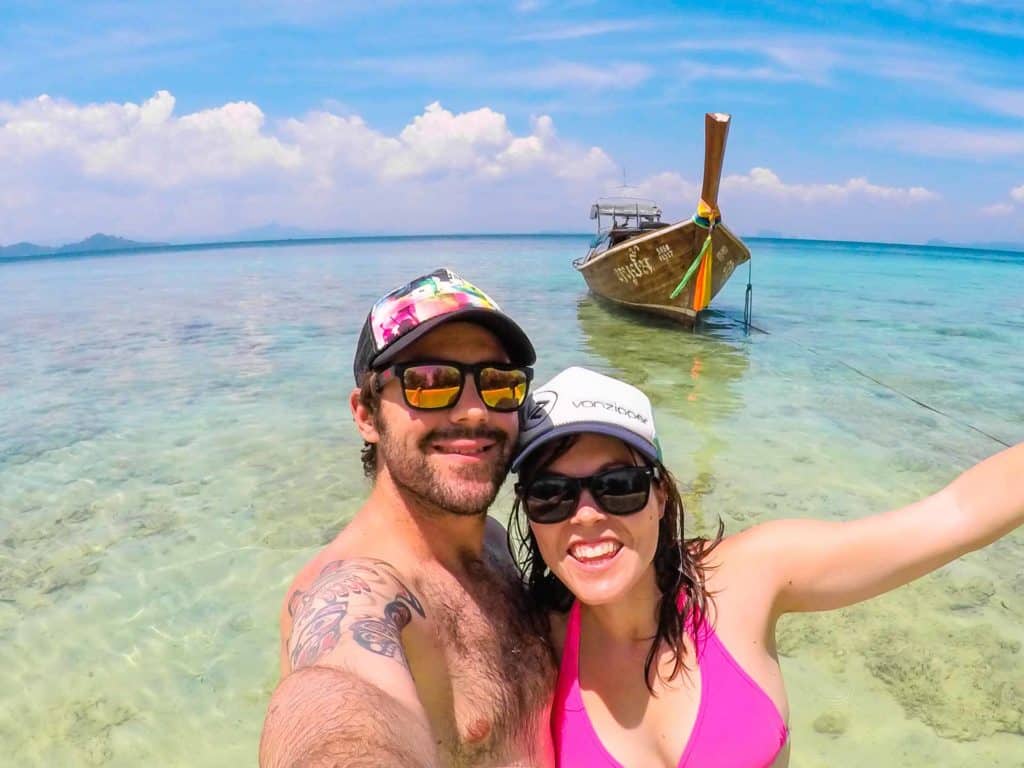
1 thought on “11 AWESOME Things to Do in Kanchanaburi, Thailand (2025)”
cheers for that… good info. Been to Thailand 18 times but not there yet but on my next visit soon…. I will be checking out some of these places…. Its always important for travellers to pass on information.